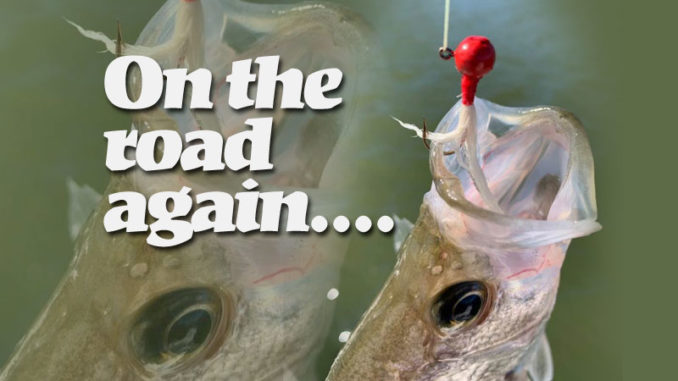
Put on your travelling clothes; you’ve got to be on the move when Louisiana crappie enter the post-spawn.
For the most part, the crappie spawn is over in Louisiana, which means fish are on the move. But that doesn’t mean you can’t catch them just because “they’re on the road” again, you know, like country singer Willie Nelson.
Crappie are in a state of transition, heading from the extremely shallow waters of the spawn in search of a good place to hole up for the summer. Basically, they are retracing their “road” back to the deeper water that they used when coming into the shallows a couple of months ago.
Two of Louisiana’s top crappie thumpers, Clyde Folse of Raceland and Greg Davis of Tullos, share their best tips for making your April and May fishing trips good ones. Both these experts know crappie baits inside and out, being lure manufacturers as well as anglers.
“It’s a tough time to catch crappie, but it doesn’t mean you can’t catch crappie,” says Clyde Folse, known as the “Crappie Psychic” for the lures of the same name he makes. “The thing that makes it tough is that they are on the move. What it means is that fishermen are going to have to do a lot more searching, a lot more moving around. That’s what the fish are doing, and that’s what we have to do, too.”
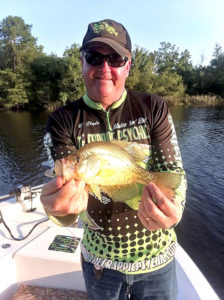
The Sac-a-lait Psychic
Folse’s main fishing spots are in south Louisiana. In fact, he laughs at the grief his Cajun buddies gave him about his nickname.
“They said, ‘Man, you should be the Sac-a-lait Psychic, not the Crappie Psychic,’” he said.
But Folse had to stick with crappie because that’s the common name for the fish across the country. But everywhere he goes teaching crappie seminars, he lets folks know it’s the sac-a-lait that got him going.
“I can tell you, without a doubt in my mind, whether you are fishing for crappie, sac-a-lait or white perch, they’ll all be doing the same thing, and you can catch them the same way. I’ll guarantee that,” he said.
The lakes in Folse’s backyard are prime examples of how he approaches the post-spawn.
“There are two big lakes; Lac des Allemands and Lake Beouf are great crappie lakes,” he said. “If you looked on Google Maps, you’d see that they are connected by the long Bayou Beouf. Lake Boeuf is a great spawning lake, and thousands of crappie head there to spawn, but when they start coming out, they head down Bayou Beouf and make their way back to Lac Des Allemands. All along the way, you can find them moving this time of year.
“There are also some other canals and cuts off the bayou and Des Allemands where crappie spawn, but the one thing they have in common is they are heading back to the bigger water, deeper water and good places that will hold plenty of food for them in the late spring and summer.”
The search
Finding fish just takes time. Folse is fortunate. He already knows most of the good places to look. Folse describes himself as “old school” — he doesn’t rely on electronics; he relies on what he knows from more than 30 years fishing for crappie. He said one of the main differences between the spawn and postspawn is depth. During the spawn, fish are 10 to 14 inches deep under the cut grass right up on the bank. As they migrate back out, they are in 2 to 4 feet of water more out from the bank.
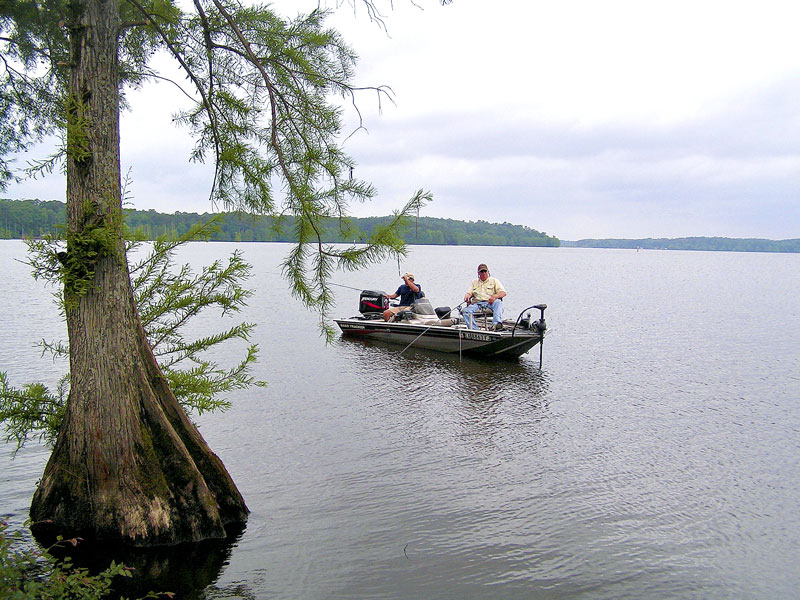
Old school
Folse is also old school when it comes to lures, too. Unless somebody is beating him with another color, he sticks with his go-to black and white jigs. He uses a 1/6-ounce jighead, not because of the weight, but because the larger No. 2 hook allows him to add his soft-plastic lures to the jig.
“I always put a Crappie Psychic trailer on my hook first. I like using the chartreuse color on the black and white jig. I push it all the way up to the back of the tube or plastic tail,” he said. “Then, I add a Psychic Ammo bead on the hook and slide it down where it holds the trailer in place. The ammo is loaded with scent; it plays a double role. Never underestimate the importance of scent in fishing for crappie. It’s an awesome combo, and I always use them both.”
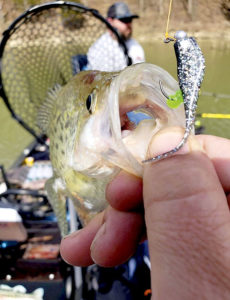
Folse has added a new lure to his arsenal, the just-relased Crappie Weapon, a tube jig with two legs. He fishes it under a cork, popping it a few times to get the fish’s attention when they are aggressive and then letting it sit without moving when the fish are a bit more timid. He changes his tactics some, but that black and white jig, Psychic trailer and ammo and a cork are standard equipment year-round.
A captive audience
“I tell my buddies and my pro staff crappie anglers that are fishing in other areas on the big lakes and reservoirs that they’ve got it easier when the fish are on the move,” Folse said. “They are fishing for a captive audience. Their crappie aren’t going anywhere. They may be on the move, but they can’t go as far as ours can down here.
“We’ve got literally hundreds of miles of canals and bayous and lakes and swamps that they can swim to. They can be anywhere. When the are in transition, you can catch the fire out of them one day and think you are on them, then the next day they are gone. You can’t let that deter you. You just have to get back on the move again and find them again.”
Same game, different water
Fishing in some north Louisiana waters is a bit different, but in some of the smaller, river-like lakes, it is more similar than you would think. Greg Davis of Tullos not only manufacturers excellent crappie lures — Crappie G Custom Hair Jigs — he’s an expert fisherman. Crappie on big lakes like Toledo Bend, Caney and D’Arbonne go to deeper holes in the transition period. They head out to 10 to 15 feet of water, and even though they suspend shallow, they do switch depths.
Davis fishes lakes in the north and central part of the state like Old River below Jena, Woolen Lake at Hebert, Lafourche Lake in Richland Parish and Saline Lake near Winnfield. These lakes are not that much different than south Louisiana crappie holes. The crappie do move, but sometimes it isn’t as far as some anglers might think.
“For sure, the fish are tougher to catch this month, because they are tired from the spawn and need to go somewhere they can rest and rejuvenate,” he said. “They are sluggish, but if you move around and find them, you can catch them.”
Cover
Davis fishes a hair jig most of the time. Some of the lakes he fishes have cypress trees, and after the spawn, fish move out to the deeper trees. They also look for brushtops and laydowns, logs in the water or man-made tops that anglers have sunk. But one thing that he’s found might surprise some anglers.
“Once the fish get feeling a little bit better this month, they will often move into extremely tight cover, and the water may not be but a couple of feet deep,” he said. “A couple of examples of that include floating mats of salvinia vegetation, lily pads or any kind of floating grass. The fish will get up under them and stay there for months. They’ll also get up in the green brush along the banks, and they’ll get way up in there.
“In the green brush, it’s like fishing in a briar thicket. You actually have to reel your jig all the way up to the tip of your pole, poke it through an opening and then drop it down a foot or two in the water. If they are there, they’ll nail it immediately. In the floating grass mats, it’s very similar. We will take a rake or something and make a hole in the mat, then drop the jig in.”
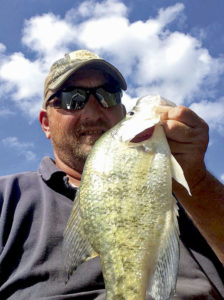
Here’s why
Here are several reasons Davis thinks fish go to those places in the post-spawn. First, there’s abundant food, from minnows to grass shrimp to all kinds of bugs and baitfish. Second, it’s shady, and third, they have some protection from predators.
Davis usually goes with black/chartreuse jigs in just about any kind of water. He fishes orange/white when the water is muddy, and when the water is greenish to clear, he likes Millwood Monkey: a dark green jig with a black tail.
“I make every color combination that you can imagine and several you probably couldn’t imagine,” he said. “It’s all about what you are confident in and what works for you.”


